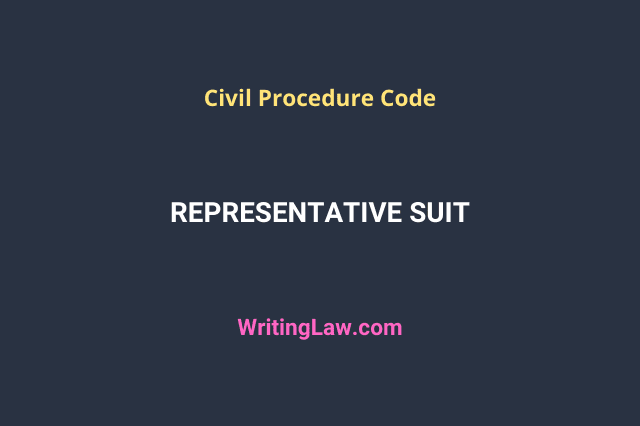
A representative suit is one that is filed by or against one or more people on behalf of themselves and others who have a vested interest in the outcome of the suit.
Representative suit is based on public policy. It saves time, money, labour and prevents multiplicity of suits. Order 1 Rule 8 of the Civil Procedure Code deals with representative suits.
As a general rule, all persons interested in a suit should be joined as parties to it so that the matter involved therein may be finally adjudicated upon and fresh litigation over the same matter may be avoided. Rule 8 of Order 1 of the Civil Procedure Code (CPC) is an exception to this general rule.
In Diwakar Shrivastava vs the State of Madhya Pradesh (1984), it was stated: “the rule provides that when there are several persons similarly interested in a suit, one or more of them can, with the permission of the court or on the direction from the court sue or be sued on behalf of themselves and others.”
Order 1 Rule 8 of CPC is an enabling provision and does not compel an individual to represent a body of person having the same interest if his action is maintainable without joining the rest in the suit.
Note: The head of the plaint and the contents of the plaint should mention that it is a representative suit.
Essential Elements of Representative Suit
For the application of Order 1 Rule 8 of the Civil Procedure Code following elements must be fulfilled:
1. There Should Be Several Parties
The first condition for a representative suit is several parties. The word “several parties” imply a group of persons and does not mean innumerable persons.
In Hasanali vs Mansoorali (1947), the Privy Council held that a representative suit on behalf of inhabitants of a village regarding village property or on behalf of the members of the sect, caste, the community is maintainable under this rule.
2. They Must Have the Same Interest
Community’s interest is the next essential, and it is the condition precedent for bringing a representative suit. Hence the interest must be common to all, or they must have a common grievance they seek to redress. It is not necessary that the interest must have arisen from the same transaction. The explanation clarifies that the person need not have the same cause of action.
3. Permission or Direction by the Court Is Necessary
The suit does not become a representative suit until the court grants the permission or the directions have been given by the court. The proper course is that the permission of the court must be obtained before the suit is filled.
4. Notice Must Be Given
All interested persons who would be bound by the decree shall be given notice. Notice may be in person or public. In Kumaravelu Chettiar vs T.P. Ramaswami Ayyar (1933), the Privy Council held that the issue of notice is peremptory, and if it is not given, the decree will bind only those parties who are on record.
Addition or Substitution of Parties
Order 1 Rule 8 sub-rule 3 of the Civil Procedure Code provides that any person on whose behalf a suit is filed or defended under sub-rule 1 of the Civil Procedure Code may apply to the court to be added as a party to the suit. Such a person must show that the conduct of the suit is not in proper hands and that his interest will be seriously affected by his prejudice if he is not joined as a party to the suit.
However, sub-rule 5 of Order 1 Rule 8 of the Civil Procedure Code, added by the Amendment Act of 1976, provides that if any person suing in a representative capacity or defending a representative suit fails to proceed with due diligence in the suit or defence, the court may substitute any other person having the same interest in the suit in his place.
Withdrawal or Compromise of Representative Suit
The following provisions are provided regarding withdrawal and compromise of a representative suit in CPC:
- Under sub-rule 4 of Rule 8 Order 1 of the Civil Procedure Code, no part of the claim in a representative suit can be abandoned under sub-rule 1 of Rule 8, Order 1 of the Civil Procedure Code.
- No such suit can be withdrawn under sub-rule 3 of Rule 1 Order 23 of the Civil Procedure Code.
- Under Order 23 Rule 3 of the Civil Procedure Code, no agreement, compromise or satisfaction can be recorded in any such suit.
Unless the court has given notice to all the interested. Such notice will be given at the expense of the plaintiff.
Res Judicata
Explanation VI of section 11 of the Civil Procedure Code deals with the representative suit. It states that where the representative suit has been decided, it will operate as res judicata.
Read Next:
1. Meaning of Res Judicata in Civil Procedure Code
2. What Is Suit of Civil Nature in Civil Procedure Code
- What Is a Foreign Judgement and When It’s Not Binding in India - 26th July 2022
- What Are Second Appeals Under Civil Law - 23rd June 2022
- Civil Appeal as Per the Civil Procedure Code - 12th June 2022







